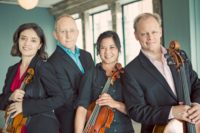by Delaney Meyers

The first piece will be Shostakovich’s String Quartet No. 1. In a recent phone conversation, Arianna violist Joanna Mendoza said that this quartet is “not so well known.” She explained that the early composition was written “during a good time in Shostakovich’s life, when he’d just had his first baby, Maxim. It has a real freshness and brightness to it that his later works don’t.” She added that, out of his fifteen quartets, “it sounds least like the Shostakovich many listeners have come to expect.”
The Quartet will be also be performing a new work composed for them by jazz pianist, Webster University professor, and friend Kim Portnoy. This commission came about after first violinist John McGrosso heard Portnoy’s jazz trio perform a version of it at a house concert and thought, “What would this be like for string quartet?”
Of the work, Mendoza said, “A great tone row begins the piece. It starts off sounding very much like Webern in the kind of disjointed way that we would hear in his 12-tone pieces. You would never think that Webern could be bluesified, but Portnoy manages to do it. It’s a really fun piece.”
Bartok’s String Quartet No. 2, a piece the Quartet is revisiting, will give the audience a chance to hear some of the “bread and butter of the string quartet repertoire.” Mendoza said that it is “a wonderful warhorse of a piece; just a great, great work.” The Arianna will be joined by Credo founder, artistic director, and violist Peter Slowik for the final work, Brahms’ String Quintet Op. 88.
Slowik will also appear on the Credo faculty concert on Friday, July 6 at 8:00 pm, again in Kulas Recital Hall, for what he describes as a fun, stylistically diverse program that increases in complexity as it progresses. “The first half goes 1, 2, 3, 4, 5 in terms of the number of players. It’s a way of preparing the audience’s ears for the complexity of the second half,” Slowik said.
That second half will be Brahms’ famously intricate G-minor piano quartet. “If you’re not singing the rondo theme when you’re leaving the concert, you haven’t been paying close enough attention,” Slowik says.
Slowik also had some words about the value of faculty concerts at summer festivals. “They’re a really important part of what happens. It’s where the students get to see the faculty lead by example, and see us put into actions things which we can’t even put into words. Faculty can share their experiences with the students in an almost visceral way.”
Another enjoyable aspect of putting on a faculty concert is the opportunity to “deepen friendships over musical connections,” Slowik explains. “I’m really delighted to work with my Oberlin faculty colleagues, Sibbi [Bernhardsson] and Jim [James Howsmon]. A program like this allows us to celebrate new and old friendships working in new combinations.”
The schedule at Credo? It’s all-consuming: “When you’re training students to play outreach concerts on Thursday and their own concerts on Saturday, to put a faculty concert in there on Friday is pretty intense.” But, Slowik assures me, “Credo faculty wouldn’t have it any other way.”
Mendoza had some closing words about Credo as a whole. “It’s just really impressive — it seems that every time we come the program grows and deepens, and it’s really wonderful to see how it’s expanded.” More information about other Credo concerts and events can be found here.
Published on ClevelandClassical.com June 28, 2018.
Click here for a printable copy of this article




